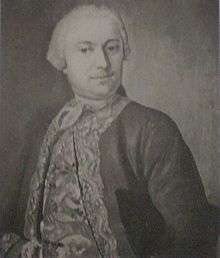Nicolás del Campo
Nicolás Francisco Cristóbal del Campo, Marquis of Loreto (March 12, 1725 – February 17, 1803) was a Spanish politician and soldier who occupied several posts in the Spanish American colonies, mainly in the River Plate area.
Nicolás del Campo | |
|---|---|
 | |
| Viceroy of the Viceroyalty of the Río de la Plata | |
| In office March 7, 1784 – December 4, 1789 | |
| Monarch | Charles III of Spain Charles IV of Spain |
| Preceded by | Juan José de Vértiz y Salcedo |
| Succeeded by | Nicolás de Arredondo |
| Personal details | |
| Born | March 12, 1725 Seville, Spain |
| Died | February 17, 1803 (aged 77) Madrid, Spain |
| Nationality | Spain |
| Occupation | Military |
| Military service | |
| Allegiance | Spanish Empire |
| Branch/service | Spanish Army |
| Rank | Brigadier General |
Biography
He was born in Seville to Josefa Arcadia Rodríguez and Nicolás Ignacio del Campo y Cuesta, First Marquis of Loreto. His father was of Flemish descent, and his original family name, van der Velde, was Hispanicized to del Campo.
Del Campo was a member of the Seville Economic Society of Friends of the Country, and later joined the Spanish Army. He rose to the rank of Brigadier General and participated in the Spanish invasion of Portugal (1762) and the Great Siege of Gibraltar (1779).
The Marquis of Loreto was appointed Viceroy of the Río de la Plata, and served from March 7, 1784, to December 4, 1789; he succeeded Juan José de Vértiz y Salcedo after the latter's resignation.[1]
As with other viceroys, he was a professional military officer but did not have experience in politics in Spanish America before arriving in Buenos Aires. He became an honest and capable administrator, and in 1785 initiated the improvement and expansion of the Real Audiencia de Buenos Aires created in 1783 by his predecessor.[2] He established the subdivisions on Intendancies (Spanish: Intendencias) in the River Plate, instituting eight Intendancies,[3] and a new system of relations between the mayors and the viceroy. Four intendancies were in Upper Peru (La Paz, Potosí, Cochabamba, Charcas, and Paraguay). The other three comprised Buenos Aires and the region south to Patagonia; Córdoba; and Salta, including the present Argentine Northwest.[4]
He fomented the economy in many levels, promoting agriculture and cattle raising, looking for new sources of good quality salts at low cost to facilitate the salting of meat for export. He improved port infrastructure, fought contraband and introduced new policies of pacific co-existence and commerce with the natives.[4] He also granted bereavement benefits for widows and orphans of Navy personnel; the 1785 edict created the first pension system in what today is Argentina.[5]
Virrey Loreto Street, in the Belgrano ward of Buenos Aires is named in his honor.[6]
References
- Britannica
- (in Spanish) Document opening the Real Audiencia de Buenos Aires Archived 2010-01-16 at the Wayback Machine
- David Rock, Argentina 1516-1987 ISBN 0-520-06178-0
- Historical Dictionary of Argentina. Scarecrow Press. 1978.
- "Institucional: Historia del ANSES". Archived from the original on 2011-08-24.
- (in Spanish) Buenos Aires - Barrios De Chacarita y Colegiales - Nuestras Calles Archived 2010-03-13 at the Wayback Machine
| Preceded by Juan José de Vértiz y Salcedo |
Viceroy of the Río de la Plata 1784–1789 |
Succeeded by Nicolás Antonio de Arredondo |